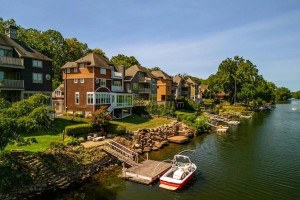Why Bikeability Is a Real Estate Story

Indego bike stations like this one in front of the Cecil B. Moore branch of the Free Library in Sharswood form a link in an emerging alternative transportation network that many house-hunters find increasingly appealing. | Photo: Sandy Smith
Earlier today, we reported on the latest rankings from Walk Score, which listed the most bikeable downtowns in the United States based on their Bike Score rankings.
One might think at first glance that this is a transportation story. But there’s a reason the news came from one of the nation’s largest online brokerages aside from the fact that the brokerage, Redfin, owns Walk Score.
If you’ve been following reports in this section over the last few months (like this one, for instance), you should have picked up on a growing preference among home buyers for homes in locations where they can choose how they will get from home to where they want to go.
Redfin agent Minh Che, based here, has certainly noticed the trend. “I’ve noticed an increased interest on the part of buyers when it comes to homes that have bike storage — an easement or alleyway where they can store their bikes. Instead of homes that have parking or similar amenities, these buyers have prioritized homes with bike amenities.
“Sometimes you will see people using the garages in their homes as bike storage space [instead]. Especially in South Philly, people have been looking for homes with places to store their bikes, either inside the home or in a back yard.”
The presence of an extensive network of bike lanes and bike trails has helped push this trend along, said Che, who sometimes uses the Schuylkill Banks trail to reach showings and open houses himself.
That network makes it possible for some buyers to do something they might not have done in years past: Ditch their car in order to live where they want. “Throughout Philadelphia, finding a home with a garage can be difficult, especially with older townhomes,” said Che. “So buyers may opt to get rid of their car, or store it in a garage down the street, and opt for a bike-friendly home instead.”
Redfin spokesperson Alina Ptaszynski said that while the company has not yet done research into the relationship between access to bike infrastructure and house values, it has already identified alternate transportation that does boost house prices. “There’s definitely a price premium for [homes] near public transportation,” she said. “We haven’t done research yet for bike access, but where there has been smart planning by the government for multimodal transportation, homes in those areas have been growing in popularity over auto-dependent neighborhoods, and you do pay a premium for that.”
The same Philadelphia neighborhoods that rate high on the Bike Score metric also have high Transit and Walk Scores as well. Rittenhouse Square, the city’s most walkable neighborhood (Walk Score: 99), also has a perfect Transit Score of 100 and a Bike Score of 96. Washington Square West, which Walk Score ranks as the city’s fourth most walkable neighborhood with a Walk Score of 98, also has a 100 Transit Score and a Bike Score of 96.
Ptaszynaski, citing figures supplied by Deputy Managing Director for Transportation and Infrastructure Clarena Tolson, noted that there is even a connection between great bike infrastructure and great transit service: “The figures show that people are using Indego for the first and last mile and SEPTA for the main line haul,” she said.
This paints a picture that should make both bike and transit advocates happy: neighborhoods where Indego bike stations provide on-demand feeder service to local destinations, including SEPTA transit stations where riders transfer to trains for the journey into town. It’s a total transportation ecosystem that developers and real estate agents can profit from, and the savvy ones like Che are taking advantage of it.
Follow Sandy Smith on Twitter.


